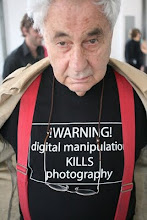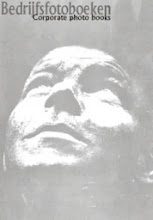
 PARIS.- The Centre Pompidou presents the first ever French exhibition devoted to the photographic work of the Czech artist Miroslav Tichy (see for a review by 5B4), a singular figure now more than 80 years old. His timeless and unclassifiable work, first introduced to the wider public at the Seville Biennale by curator Harald Szeemann, reveals a unique, marginal and somewhat monomaniacal talent.
PARIS.- The Centre Pompidou presents the first ever French exhibition devoted to the photographic work of the Czech artist Miroslav Tichy (see for a review by 5B4), a singular figure now more than 80 years old. His timeless and unclassifiable work, first introduced to the wider public at the Seville Biennale by curator Harald Szeemann, reveals a unique, marginal and somewhat monomaniacal talent.The exhibition brings together a number of cameras and some hundred photographs, mostly from the Foundation Tichy-Ocean, as well as works from the collection of the Centre Pompidou.
Between the early 1960s and the mid 1990s, in Communist Czechoslovakia and in self-imposed artistic isolation, Miroslav Tichy created a body of work obsessively concerned with the female figure, reinventing art photography from scratch.
 His images, shot instinctively or carelessly on his handmade cameras with their makeshift optics, offer an extraordinary vision of a fantastical, eroticised reality, half real, half dream, revealing an uncategorizable artist strongly influenced by the classical pictorial tradition whose methods nonetheless recall those of the amateur, or the naivety of outsider art. Exhibited for the first time in 2004, Miroslav Tichy’s photographs, timeless and unclassifiable, stand witness to a unique talent.
His images, shot instinctively or carelessly on his handmade cameras with their makeshift optics, offer an extraordinary vision of a fantastical, eroticised reality, half real, half dream, revealing an uncategorizable artist strongly influenced by the classical pictorial tradition whose methods nonetheless recall those of the amateur, or the naivety of outsider art. Exhibited for the first time in 2004, Miroslav Tichy’s photographs, timeless and unclassifiable, stand witness to a unique talent.Born in Moravia in 1926, the only child of a tailor, Miroslav Tichy trained at the Academy of Fine Arts in Prague in the years immediately following the Second World War. Having embarked on a career as a painter, influenced by Picasso, Matisse and the German Expressionists, after the Communist takeover of power in 1948 he turned his back on the official art world. Returning to Kyjov, the town of his birth, he abandoned painting and in the mid-Fifties took up photography, building his own cameras from shoe-boxes, tin cans, recycled glass and other waste materials.
For more than thirty years – that is, until the late 1980s – he lived a life of personal and cultural isolation, but took dozens of photographs every day, his great subject being the women of the town.
His deliberately marginal and fiercely nonconformist way of life, so little in accord with the ideology of the day, led to repeated run-ins with the authorities, leading to several periods of confinement in psychiatric institutions in the Sixties and Seventies, and to his losing his studio in 1972.
 His images, shot instinctively or carelessly on his handmade cameras with their makeshift optics, offer an extraordinary vision of a fantastical, eroticised reality, half real, half dream. Women at the swimming-pool, women in the street, women indoors, women on the TV screen: these are his single, obsessional subject. Enlarged and printed on his own improvised equipment, the photographs were then often retouched before being mounted and framed using such materials as old newspaper and cardboard before, sometimes, being put away and forgotten for years.
His images, shot instinctively or carelessly on his handmade cameras with their makeshift optics, offer an extraordinary vision of a fantastical, eroticised reality, half real, half dream. Women at the swimming-pool, women in the street, women indoors, women on the TV screen: these are his single, obsessional subject. Enlarged and printed on his own improvised equipment, the photographs were then often retouched before being mounted and framed using such materials as old newspaper and cardboard before, sometimes, being put away and forgotten for years.Over- or under-exposed, scratched, blurred, torn, and spotted, they nonetheless reveal an uncategorizable artist, whose methods recall those of the amateur or the naivety of outsider art, but whose images are strongly marked by influences from the classical pictorial tradition. With its endless return to the same subject and the volume and regularity of its production, his work also has affinities with many procedures of the contemporary art of the same period. See also Tarzan in pension ...
Paul Kooiker is inspired by Miroslav Tichy ...















Geen opmerkingen:
Een reactie posten